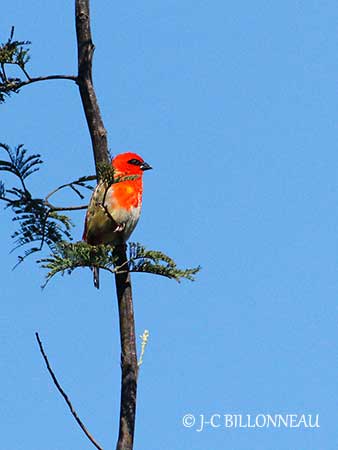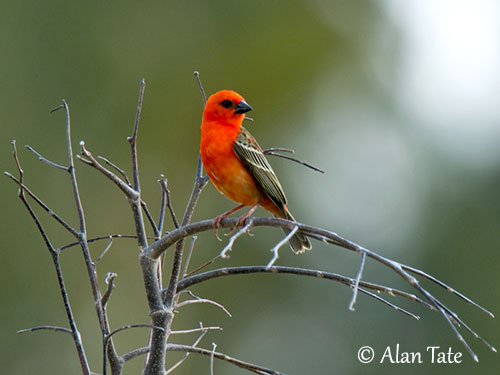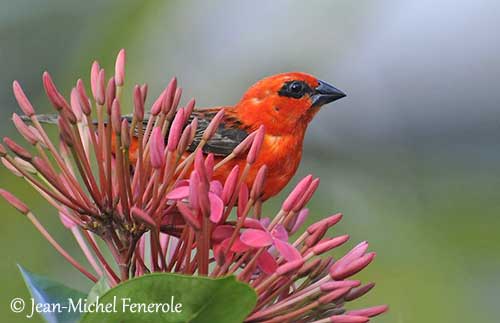
PROTECTION / THREATS / STATUS:
The Red Fody is abundant in Madagascar, and usually common where introduced. The species could hybridize with the Forest Fody (F. omissa) in Madagascar, following observations of individuals with intermediate plumage characters.
The Red Fody is a pest in rice-growing areas. Cage-traps are used, and also mist-netting at roosts as control measures.
The population is suspected to be stable and not globally threatened.
The Red Fody is currently evaluated as Least Concern.
Fr: Foudi rouge
Ang: Red Fody
All: Madagaskarweber
Esp: Fodi Rojo
Ita: Fody rosso
Nd: Madagaskarwever
Sd: röd fody
Mal: Fodilahimena, Fodimena, Fody, horovana
Photographers:
Jean-Claude Billonneau
Photographe-témoin de la Beauté du Monde
Jean Michel Fenerole
Photos d’Oiseaux du monde
Dubi Shapiro
Dubi Shapiro Photo Galleries
Alan & Ann Tate
AA Bird Photography
Text by Nicole Bouglouan
Sources :
HANDBOOK OF THE BIRDS OF THE WORLD Vol 15 by Josep del Hoyo-Andrew Elliot-David Christie - Lynx Edicions – ISBN: 9788496553682
Birds of Madagascar: A Photographic Guide Par Pete Morris, Frank Hawkins – ISBN: 0300077556, 9780300077551- Editeur: Yale University Press, 1998
Birds of Madagascar and the Indian Ocean Islands Par Roger Safford, Adrian Skerrett, Frank Hawkins – ISBN: 1472924118, 9781472924117- Editeur: Bloomsbury Publishing, 2015
Wikipedia, the free encyclopaedia
THE AVIANWEB - Beauty of Birds (Sibylle Faye)
Family Ploceidae
Page Order Passeriformes
Red Fody
Foudia madagascariensis
Passeriformes Order – Ploceidae Family
INTRODUCTION:
The Red Fody is endemic to Madagascar, but the species has been introduced on several Indian Ocean islands and other locations. The genus Foudia is part of the subfamily Ploceinae in the large family Ploceidae. The species of this genus are all native to the islands of the western Indian Ocean.
The Red Fody occurs throughout Madagascar where it is found in open habitats. It is solitary and territorial during the breeding season, but outside this period, it is very gregarious and forms feeding and roosting flocks.
The species is abundant on the island where it is considered a pest in rice-growing areas, and some control measures are currently active, especially mist-netting at roosts. The Red Fody is not globally threatened.
DESCRIPTION OF THE BIRD:
Biometrics:
Length: 13 cm
Weight: 13-20 g
The Red Fody male in breeding plumage has bright red plumage almost overall. Mantle and scapulars are red with black centres to feathers. Rump and uppertail-coverts are red. Wings and tail feathers are blackish with pale buff fringes.
The underparts are red with often paler belly. The red areas are occasionally replaced by orange or yellow.
The head is vermillion-red. There is a small, black mask around the eyes.
The bill is black. The eyes are dark brown. Legs and feet are pale brown.

Female and non-breeding male have olive-brown upperparts with indistinct central streaks on head and nape. Mantle and back show dark streaking, whereas the rump is uniformly paler. Wings and tail are blackish with broad, creamy-buff fringes, especially on wing-coverts where they may form two pale wingbars.
The underparts are pale greyish-olive with yellow wash, mainly on undertail-coverts.
On the head, the crown is olive-brown. We can see a conspicuous pale buff supercilium, contrasting with darker eye stripe, moustachial stripe and indistinct malar stripe. Ear-coverts and throat are washed yellowish. The bill is horn-coloured.
The juvenile resembles female with buffy looking before the first moult.
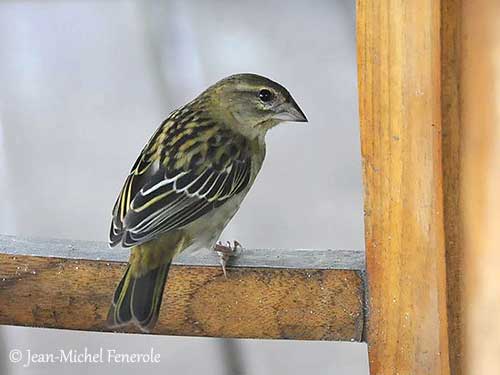
RANGE:
The Red Fody occurs throughout Madagascar where it is common. However, the species has been introduced on Reunion, Mauritius, Seychelles, Rodrigues, Amirantes and Chagos Islands in Indian Ocean. It is also on St Helena in Atlantic Ocean, and in Bahrain in Arabian Peninsula. The species is present on Glorieuses Islands and Comoro Islands, maybe colonized without human assistance.
HABITAT:
The Red Fody frequents a variety of open habitats such as savanna, scrub, areas with scattered trees, forest edges and towns. It does not frequent intact forest in Madagascar.
It roosts in bamboos, tall grasses, reedbeds, sugar cane and mangroves. The species is most common below 1,000 metres, but it has been recorded up to 2,400 metres of elevation.
CALLS AND SONGS: SOUNDS BY XENO-CANTO
The Red Fody gives high-pitched, trilling song “trrr tree tree” with sometimes short-wheezy phrases. These short notes vary slightly in pitch, and may accelerate into rapid trill. During courtship, the male gives loud “seer” and the female utters short “tsip” calls prior to copulation. The flight call is a penetrating “tsit”.
BEHAVIOUR IN THE WILD:
The Red Fody is primarily a seed-eater, but it also consumes nectar and arthropods. It feeds on rice and grass seeds of various species, taking both rape seeds or when in milky stage. They often feed in huge flocks of hundreds of individuals.
The Red Fody also feeds on arthropods including beetles, caterpillars, moths and spiders.
The nectar is taken from native and exotic plant species. The bird often takes the nectar from the base, after pulling out part of the flower.
The chicks are fed with seeds and insects.
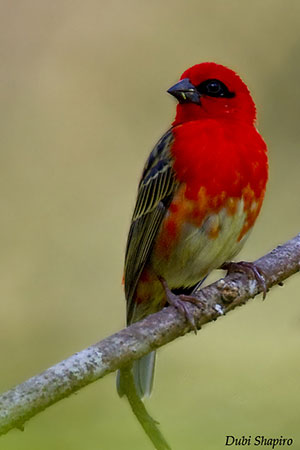
The Red Fody is monogamous. During the breeding season, the territorial male defends the territory by singing from exposed perches.
In the wild, both adults build the nest, whereas in captivity, the male builds the nest and the female only adds the lining. The nesting duties are shared by both parents.
From an observation of a male during the nest building (see the sources at the bottom of the page), some courtship behaviour is described. The male was carrying twigs in the bill, but it uttered some “chew” call display and approached the females crossing its territory. It tried to chase a female in flight before to change the direction, flying towards its nest in construction as a nest invitation. Mating may occur following this behaviour. But if the female does not reply to this display, the male abandons the nest.
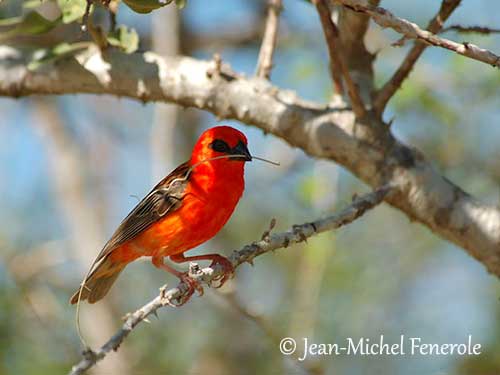
The Red Fody is resident on the island. Immature birds may disperse in flocks across the forested regions of Madagascar.
The flight is fast and direct on whirring wings.
REPRODUCTION OF THIS SPECIES:
The breeding season occurs between September and May. This season varies depending on the location on other islands.
The Red Fody builds an oval structure with a side entrance near the top, under a projecting porch or sometimes with a short tunnel. The nest is made with woven grass strips. It is placed fairly low in tree or shrub.
The female lays 2-4 pale blue-green eggs and incubates alone during 11-14 days. The chicks are fed by regurgitation of seeds and insects by both parents during the first days. They leave the nest two weeks after hatching, and then, each adult feeds 1-2 fledglings after brood division. Later, the young form discrete flocks and disperse.
This species may produce two broods per season.
The nests are sometimes destroyed by flooding, but predation by Madagascar Harrier-Hawk and large chameleons may affect the breeding success.
